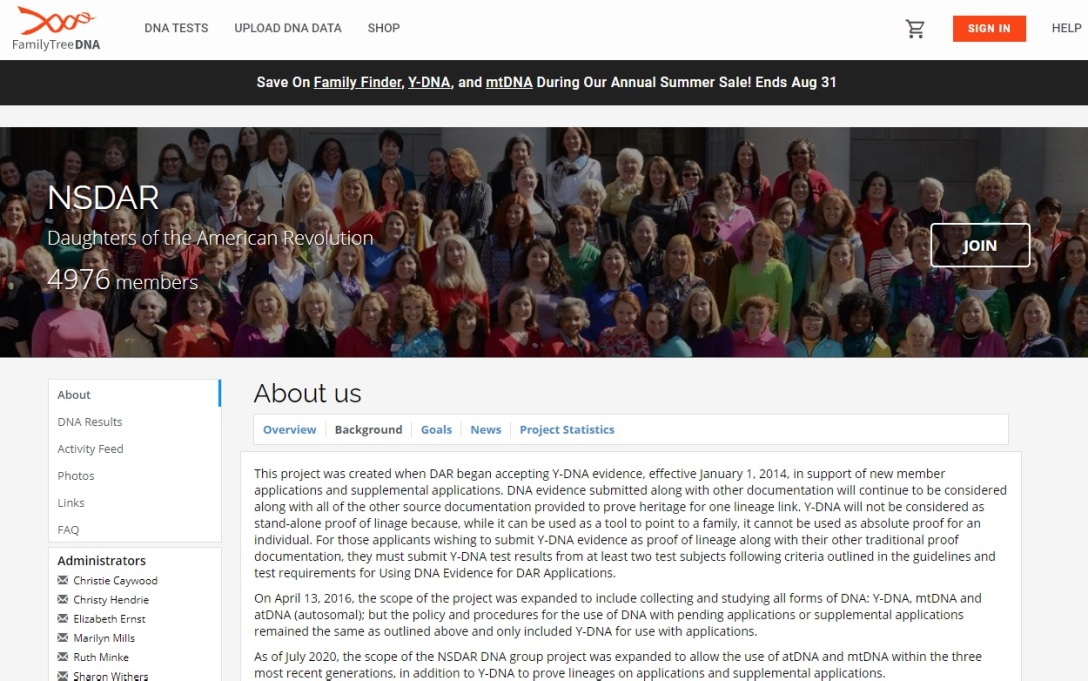
The Daughters of the American Revolution is one of the leading lineage societies. To become a member, a woman must submit documentation of her family from herself back to a person who supported the Revolutionary War. But what if the paper trail isn’t complete or accurate? DNA can help. Just last month, the DAR began accepting autosomal DNA and mitochondrial DNA evidence. Because DAR is such a major lineage society, other societies like the Mayflower Society will hopefully follow their example.
For a number of years, since 2014, Y-DNA has been accepted as evidence by the DAR. Y-DNA passes directly from father to son, unchanged except for the occasional mutation. If men descending from one branch of a family tree have Y-DNA that closely matches Y-DNA from another branch of that tree, that would be evidence that they shared a common ancestor at some point.
Y-DNA is great. It came out before autosomal testing. I did Y-DNA testing in my family to confirm for myself my own DAR application lineage. (I didn’t need to submit it as part of my application, however, because the paper trail ended up being solid.) But Y-DNA is limited in only giving evidence for father-son relationships.
Now, it is a big step forward that autosomal DNA evidence will be accepted. But it can’t be used in every situation, at least not yet. Here are some guidelines about how autosomal DNA (and mitochondrial DNA) may be used for applications:
- Autosomal DNA may be used in an analysis for one link between generations.
- Autosomal DNA may be used only within the first three generations. This link could be either the applicant to her parents (Gen 1 to Gen 2), a parent to the grandparents (Gen 2 to Gen 3), or a grandparent to a great-grandparent (Gen 3 to Gen 4).
- Autosomal DNA may be used for application or supplemental applications.
- Mitochondrial DNA can be used only if Y-DNA or autosomal DNA are used also.
- The approving genealogists prefer traditional paternity, maternity, and siblingship tests over autosomal DNA tests.
The DAR made this change to accept additional kinds of DNA evidence primarily for two groups of people:
- The applicant is an adoptee or one of their parents is an adoptee and the adoption records are sealed or don’t exist.
- A parent listed on the applicant’s birth certificate is not their actual parent, or a parent listed on the parent’s birth certificate is not the applicant’s actual grandparent, or the same for the next generation.
If anyone has a relatively close MPE, or is an adoptee, this will open up the possibility of DAR membership or additional supplementals.
To submit the autosomal DNA evidence, an applicant would need to submit an autosomal report. She should submit her test results to FamilyTreeDNA or to test there, and join the NSDAR project there. Here is the project link: https://www.familytreedna.com/groups/nsdar/about/background
I would encourage testing at Ancestry, then to upload the results to FamilyTreeDNA. According to the latest Autosomal DNA Report form (found on the DNA and DAR Applications page), the matches does not also have to upload to FamilyTreeDNA.
Overall, the DAR accepting autosomal DNA is a big step in the right direction, since this category of evidence is accepted in the wider genealogical community. Hopefully other lineage societies will follow suit, and DAR will accept autosomal DNA in even more cases in the future.
Happy researching!


